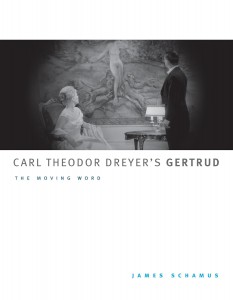Carl Theodor Dreyer's Gertrud
The Moving Word


Average rating: ![]()
| 0 | rating | |
| 0 | rating | |
| 0 | rating | |
| 0 | rating |
Your rating: -
Book Presentation:
If there is one film in the canon of Carl Theodor Dreyer that can be said to be, as Jacques Lacan might put it, his most “painfully enjoyable,” it is Gertrud. The film's Paris premier in 1964 was covered by the Danish press as a national scandal; it was lambasted on its release for its lugubrious pace, wooden acting, and old-fashioned, stuffy milieu. Only later, when a younger generation of critics came to its defense, did the method in what appeared to be Dreyer's madness begin to become apparent.
To make vivid just what was at stake for Dreyer, and still for us, in his final work, James Schamus focuses on a single moment in the film. He follows a trail of references and allusions back through a number of thinkers and artists (Boccaccio, Lessing, Philostratus, Charcot, and others) to reveal the richness and depth of Dreyer's work―and the excitement that can accompany cinema studies when it opens itself up to other disciplines and media. Throughout, Schamus pays particular attention to Dreyer's lifelong obsession with the “real,” developed through his practice of “textual realism,” a realism grounded not in standard codes of verisimilitude but on the force of its rhetorical appeal to its written, documentary sources.
As do so many of the heroines of Dreyer's other films, such as La Passion de Jeanne d'Arc (1928), Gertrud serves as a locus for Dreyer's twin fixations; written texts, and the heroines who both embody and free themselves from them. Dreyer based Gertrud not only on Hjalmar Soderberg's play of 1906, but also on his own extensive research into the life of the “real” Gertrud, Maria van Platen, whose own words Dreyer interpolated into the film. By using his film as a kind of return to the real woman beneath the text, Dreyer rehearsed another lifelong journey, back to the poor Swedish girl who gave birth to him out of wedlock and who gave him up for adoption to a Danish family, a mother whose existence Dreyer only discovered later in life, long after she had died.
About the Author:
James Schamus is a professor in the School of Arts, Columbia University, and the CEO of Focus Features. His screenwriting and producing credits include The Ice Storm, Crouching Tiger, Hidden Dragon, and a number of other films from his long collaboration with Ang Lee.
Press Reviews:
"James Schamus has great faith in the viewer's active role when facing a work of art. He pries open a single image of Carl Dreyer's Gertrud and, like a passionate explorer, leads us through a labyrinth of meanings. For him, this is a journey of discovery, and while guiding us he traces his own map to that most mythical treasure hidden in the depths of cinema: the mirror that reflects the self."―Alfonso Cuarón, director of Y Tu Mamá También
"A nimble monograph. Schamus is a true cosmopolite of the movies―- an Oscar-nominated producer and screenwriter, the CEO of Focus Features, a Columbia University film professor, and now, it turns out, a first-rate scholarly critic. Watch (Gertrude) with care, read Schamus's action-packed study, and your cinematic life will be genuinely, and permanently, enriched."―Film Quarterly
"Schamus, best known as Ang Lee’s regular screenwriter/producer (Brokeback Mountain, Lust Caution), pens a fascinating study of a single scene in Carl Dreyer’s late, Ibsenite masterpiece Gertrud (1964). Mainly for film wonks, but with passages of hypnotic perception."―Financial Times
"In this stunningly brilliant excursus of a single moment in Carl Theodor Dreyer's Gertrud, James Schamus has written a work of alchemical ekphrasis. Schamus has forged a new mode of film writing that should encourage scholars to emulate the depth and breadth of its investigation."―Anne Friedberg, University of Southern California
"Schamus creates an intricate web of connections that sheds light especially on the conflicted relation of image and text in Dreyer's films."―Brigitte Peucker, Yale University
"Lovers of cinema know Gertrud as a 'difficult' film, yet one that raises heated passions. To know why Gertrud is a film of passion is also to understand that what makes a great work of cinematic modernism is not always immediately visible. In this engaging and erudite book, James Schamus gives new and compelling reasons to love this often unloved film about the excesses and limits of love. Similar to T. J. Clark's compelling experiment in The Sight of Death, Schamus turns and returns to key moments of the film to unravel the myriad historical, philosophical, and aesthetic threads that design Dreyer's picture of modernism and the impossibility of love. Like Gertrud contemplating a tapestry and refinding a dream, Schamus leads us, in this beautifully written book, to recognize in an image a ciphered desire from which an entire story can unfold."―D. N. Rodowick, Harvard University
"Gertrud, at once monumental and mysterious, finds its ideal critic in James Schamus. His brief, probing chapters illuminate the film from so many angles―-Dreyer's life, the original play, the history of aesthetics, the institutions of cinema both then and now―-that we return to this 'failed masterpiece' with new respect, even awe. Informed by deep research and shrewd looking and listening, this study offers something one seldom finds in modern film studies: tactful eloquence in the face of sheer, enigmatic beauty. Schamus scrutinizes the monument and celebrates the mystery."―David Bordwell, Jacques Ledoux Professor of Film Studies, University of Wisconsin–Madison
See the publisher website: University of Washington Press
See Gertrud (1964) on IMDB ...
> From the same author:
> On a related topic:
Visions and Victims (2024)
Art Melodrama in the Films of Carl Th. Dreyer
Subject: Director > Carl Theodor Dreyer
Cinematography of Carl Theodor Dreyer (2018)
Performative Camerawork, Transgressing the Frame
Subject: Director > Carl Theodor Dreyer